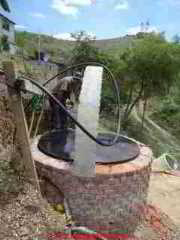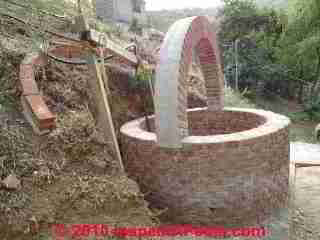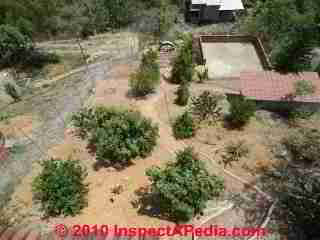 Where to Locate a Hand Dug Water Well
Where to Locate a Hand Dug Water Well
Just where should I dig the water well?
- POST a QUESTION or COMMENT about where to9 locate Hand Dug Water Wells
Hand dug water well construction details:
This article explains where to locate a hand dug well and how to start the well digging process.
This article series offers advice for Hand Dug Water Wells and the sanitation and maintenance concerns with this water supply type.This article describes the process of digging a well to provide usable water and the steps taken to make the well safe and sanitary.
InspectAPedia tolerates no conflicts of interest. We have no relationship with advertisers, products, or services discussed at this website.
- Daniel Friedman, Publisher/Editor/Author - See WHO ARE WE?
Choosing a Dug Well Location and Selecting a Well Digging Method
 Alvin Starkman M.A., LL.B., Casa Machaya, Oaxaca Bed and Breakfast.
Alvin Starkman M.A., LL.B., Casa Machaya, Oaxaca Bed and Breakfast.
[Click to enlarge any image]
We include both technical advice and a description of the practical problems that one must encounter and overcome in providing usable water in an area where public water supply is absent or limited.
Our home in Colonia Loma Linda is at the top of a hill facing the street, Calle Sierra Nevada. The lot extends to the bottom of the hill, where there’s a predominantly unpaved dirt road which during the rainy season appears more of a stream.
Our photo of our dug well (near completion, at left) shows just how steep the hillside is.
There are tell-tale signs of moisture near the bottom of our hill: trees remain green year round, a bit of river reed (carriso) grows near the bottom of our land; a neighbor has healthy banana trees; and he and another neighbor have wells. Our own fruit trees, further up our hill, have traditionally struggled, I assume in part because of the distance to the water table, and of course because of the stone substratum.
Below perhaps a foot of hard earth, our land is pure rock. We knew this when we bought it, and were able to confirm it as we watched workers digging three retaining walls for the house, by hand, excavating several feet down.
I estimated, based on a conversation with one of the lower neighbors, that if we began digging about ¾ of the way down the hill, we would have to dig a total of about 13 meters in order to reach a sufficient supply of water. The neighbor recommended a diviner / digger. He came by, we told him approximately where we would want to dig, and then he pegged the exact spot using his two lengths of reinforced steel as divining rods. And what if he was wrong? He was pretty old, which did instill a modicum of confidence.
At the time the diviner / well digger’s price seemed high, at 3,500 pesos per meter. We’d never checked around and didn’t have any friends with well-digging experience to guide us. We then spoke to Rogelio, a bricklayer whom we’d known for a few years. He advised us that he knew someone who knew how to dig a well, and that with him (Rogelio) at the helm, we could work out a weekly rate for a small team. We trusted Rogelio, so asked him to coordinate the digging, which he did.
We actually had a choice of having the well dug by hand, or by a company with well-digging machinery. An architect friend advised to go with the former, indicating that a commercial outfit would first seek municipal permission for the digging, which may or may not be forthcoming, and in any event would entail delays; so the best would be to go with a more informal arrangement. And after all, that’s what our neighbors had done – dug their wells by hand, quietly, without fanfare – and no problems with the municipality.
Digging a well by hand, through rock, entails using chisels and mallets, and no more. Some workers use a ladder to descend, while others simply shimmy up and down with the aid of a thick rope.
Beginning the Well Digging Process
 Let the Well Digging Begin in Loma Linda, Oaxaca
Let the Well Digging Begin in Loma Linda, Oaxaca
Shortly after we had moved to Oaxaca, I went to a rare contents sale with a friend, and amongst other things purchased a job lot of nails, chisels, hammers and mallets, figuring that in the course of the balance of my lifetime, some of it would be useful. I had already learned to be much handier around the house than I had been the previous 53 years. Now I had more of the supplies that I used to come across in my father’s garage.
Rogelio, in consultation with the well digger, comprised a list of materials for me to acquire: ropes, a longer ladder, and buckets.
I already had the mallets, and it was just a matter of finding an ironworker (herrero) with the machinery necessary to forge points and flat surfaces on the chisels. I had wrongly assumed that every herrero possessed all such equipment.
Our photo (left) shows at upper center the brick arch that marks the final location selected for our dug well. You can see that this well had to be dug on a steep hillside, and down-hill from the buildings and most of the property where its water would be used.
Digging of our "dug" well began in January, 2008.
I instructed: “Start digging here, where those couple of rocks are lying on the ground; not over there, not over there, it has to be right here, because that’s what the diviner said. Ensure that the diameter all the way down is at least ten centimeters wider than the outside diameter of those rings over there. We have to be able to lower them down.”
Well Digging Schedule - el Pozo
The work week on construction sites for Monday through Friday is traditionally 8 a.m. to 6 p.m. with an hour for lunch and usually a couple of impromptu short breaks.
Payday is every Saturday at 1 – 2 p.m., when workers leave for the weekend. Work proceeded reasonably well for a number of weeks, without incident, although I had already begun to regret the weekly pay arrangement rather than a fixed amount per meter.
It seems as though construction workers will make what they expect they should make, regardless of the arrangement. The difference is that if you pay by the project, or in this case by the meter, you know as best possible what your cost will be. If it’s by the week, you’re at the mercy of your trabjadores and their work ethic.
Paying the Well Crew
Mid-digging we decided to leave Oaxaca for a few days, not anticipating being back until late Saturday or Sunday. Friends were minding the house for us. We gave them the weekly pay for the crew, and asked them to pay the money to the boss (in our mind, clearly Rogelio) on Saturday afternoon.
Our friend gave the money to the wrong person – the well digger, instead of Rogelio who would traditionally take all the money and pay himself and the two workers. The well digger ran away with the money for all three. Upon our return from our brief vacation we learned of what had happened, and while Rogelio knew the well digger and in fact had coordinated with him to work on our job, the scoundrel was nowhere to be found, and certainly not at his home.
It’s not totally uncommon for this kind of thing to happen, right down to the culprit failing to return home, and hiding out elsewhere, often in his village in another part of the state.
We felt bad for Rogelio, and he felt bad for himself, recognizing that the obligation was his to track down the thief, since he had been working for us based on Rogelio’s assurance of his honesty. We suspended work, and never did hear from Rogelio about the outcome, although he has returned to our home to do more traditional bricklayer jobs.
...
Reader Comments, Questions & Answers About The Article Above
Below you will find questions and answers previously posted on this page at its page bottom reader comment box.
Reader Q&A - also see RECOMMENDED ARTICLES & FAQs
Question:
(Jan 23, 2013) chris said:
we have a 50 ft deep x 24 inch dia.concrete pipe casing bored well that leaks around the 1st joint at 20 inches beneath the ground level..this is where the 1 inch pvc pipe comes thru to our house.what should we use to seal this?
Reply:
Chris please see the suggestions at WELL CASING LEAK REPAIRS
...
Continue reading at SUSPEND DIGGING THE WELL: WET SEASON or select a topic from the closely-related articles below, or see the complete ARTICLE INDEX.
Or see these
Recommended articles
The links below provide the details of how to dig and construct a hand dug water well.
- HAND DUG WELLS - home
- HAND DUG WELL PROCEDURE
- SAFETY WARNINGS for WELL DIGGERS
- BUILD A HAND DUG WELL
- DECIDING TO DIG a WELL: QUESTIONS
- CHOOSE WELL LOCATION & DIGGING METHOD
- BEGIN DIGGING THE WELL
- SUSPEND DIGGING THE WELL: WET SEASON
- WELL RINGS: WHEN TO USE or OMIT
- DUG WELL DEPTH: HOW DEEP IS ENOUGH?
- DUG WELL WATER QUANTITY: HOW MUCH IS ENOUGH?
- WELL ARCH: BUILDING
- WELL SAFETY WALL & COVER
- DUG WELL POTABILITY TEST
- DUG WELL SANITATION PROTECTION
- HAND DUG WELL WATER in PHUKET
- WELLS CISTERNS & SPRINGS - home
Suggested citation for this web page
CHOOSE WELL LOCATION & DIGGING METHOD at InspectApedia.com - online encyclopedia of building & environmental inspection, testing, diagnosis, repair, & problem prevention advice.
Or see this
INDEX to RELATED ARTICLES: ARTICLE INDEX to WATER SUPPLY, PUMPS TANKS WELLS & SPRINGS
Or use the SEARCH BOX found below to Ask a Question or Search InspectApedia
Ask a Question or Search InspectApedia
Try the search box just below, or if you prefer, post a question or comment in the Comments box below and we will respond promptly.
Search the InspectApedia website
Note: appearance of your Comment below may be delayed: if your comment contains an image, photograph, web link, or text that looks to the software as if it might be a web link, your posting will appear after it has been approved by a moderator. Apologies for the delay.
Only one image can be added per comment but you can post as many comments, and therefore images, as you like.
You will not receive a notification when a response to your question has been posted.
Please bookmark this page to make it easy for you to check back for our response.
IF above you see "Comment Form is loading comments..." then COMMENT BOX - countable.ca / bawkbox.com IS NOT WORKING.
In any case you are welcome to send an email directly to us at InspectApedia.com at editor@inspectApedia.com
We'll reply to you directly. Please help us help you by noting, in your email, the URL of the InspectApedia page where you wanted to comment.
Citations & References
In addition to any citations in the article above, a full list is available on request.
- Alvin Starkman, Casa Machaya, Oaxaca Bed and Breakfast, Sierra Nevada 164, Col. Loma Linda, Oaxaca, Oaxaca 68024, Mexico, cel: 0449515057793, casa: (951) 1328203, For inquiries, rates and reservations, email Casa Machaya at oaxacadream@hotmail.com
Mr. Starkman is a retired Toronto attorney who operates the Casa Machaya bed and breakfast in Oaxaca Mexico. - Dempster Industries is a contemporary manufacturer of hand pumps for shallow wells or hand dug wells.
At http://www.dempsterinc.com/html/Handpump.html you can find Dempster Industries who can tell you exactly how to repair mechanical problems with your well pump. Here is the Dempster installation manual for a typical hand pump used on shallow wells or dug wells: http://www.dempsterinc.com/PDF%20FIles/Typical%20Hand%20Pump%20Installation.pdf - Access Water Energy, PO Box 2061, Moorabbin, VIC 3189, Australia, Tel: 1300 797 758, email: sales@accesswater.com.au Website: http://www.accesswater.com.au/
Moorabbin Office: Kingston Trade Centre, 100 Cochranes Rd, Moorabbin, VIC 3189
Australian supplier of: Greywater systems, Solar power to grid packages, Edwards solar systems, Vulcan compact solar systems, water & solar system pumps & controls, and a wide rage of above ground & under ground water storage tanks: concrete, steel, plastic, modular, and bladder storage tanks. - In addition to citations & references found in this article, see the research citations given at the end of the related articles found at our suggested
CONTINUE READING or RECOMMENDED ARTICLES.
- Carson, Dunlop & Associates Ltd., 120 Carlton Street Suite 407, Toronto ON M5A 4K2. Tel: (416) 964-9415 1-800-268-7070 Email: info@carsondunlop.com. Alan Carson is a past president of ASHI, the American Society of Home Inspectors.
Thanks to Alan Carson and Bob Dunlop, for permission for InspectAPedia to use text excerpts from The HOME REFERENCE BOOK - the Encyclopedia of Homes and to use illustrations from The ILLUSTRATED HOME .
Carson Dunlop Associates provides extensive home inspection education and report writing material. In gratitude we provide links to tsome Carson Dunlop Associates products and services.

